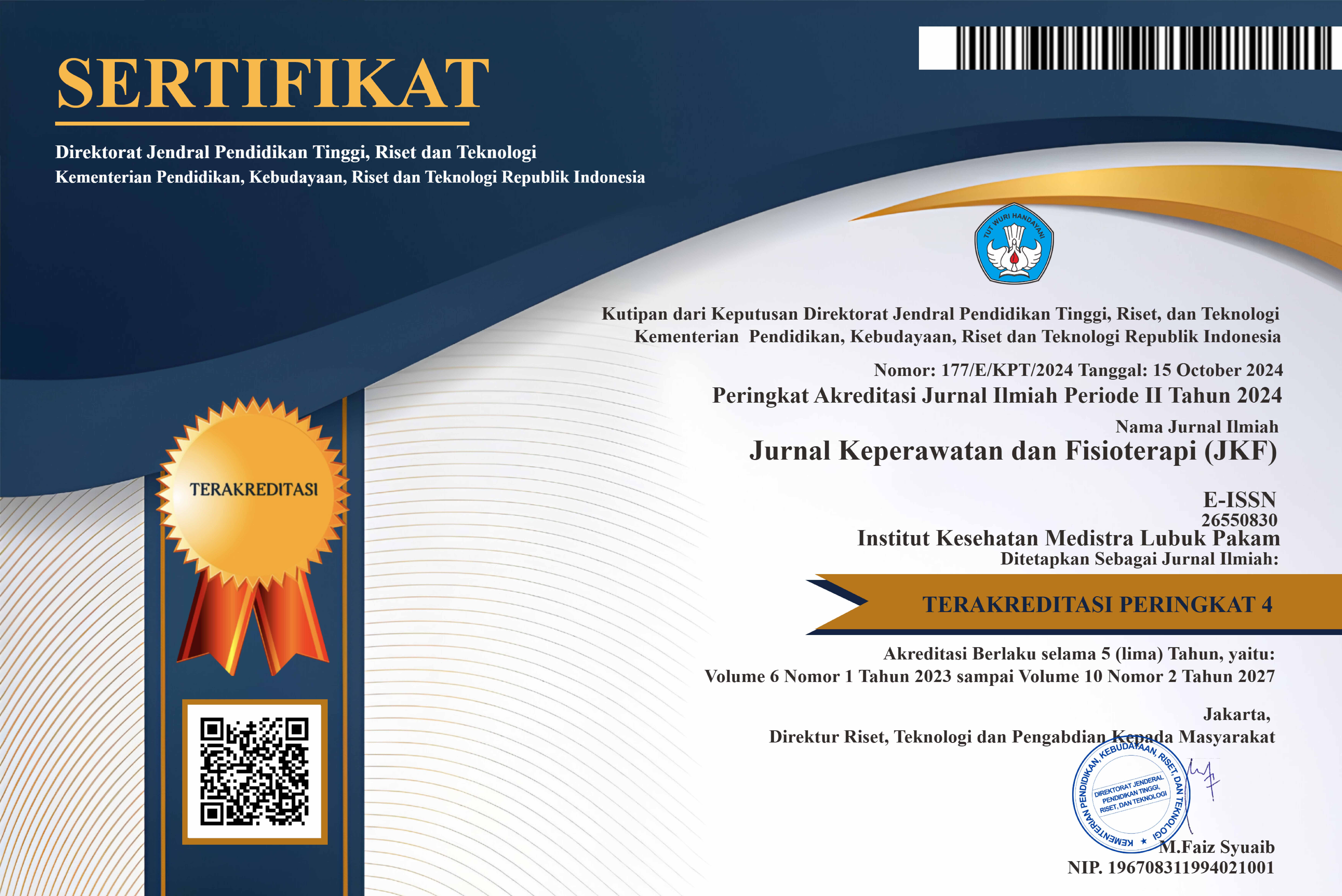Effectiveness of Propioceptive Neuromuscular Facilitation in Improving Walking Quality in Post-Stroke Patients at Haji General Hospital Medan
DOI:
https://doi.org/10.35451/jkf.v7i1.2155Keywords:
pasca-stroke, pnf, kualitas berjalanAbstract
Nationally, the prevalence of stroke in Indonesia in 2018 was 10.9 per mile, an increase compared to 2013 which was 7 per mile. Stroke is the second leading cause of death and the third leading cause of disability in the world. Two-thirds of stroke events occur in developing countries. Weakness and decreased muscle strength in stroke sufferers occur on one side of the limb, however, in the trunk muscles, weakness occurs on both sides, resulting in limited trunk rotation and difficulty in maintaining balance and gait). Propioceptive Neuromuscular Facilitation (PNF) is a physiotherapy intervention method that can be used to improve the quality of walking in stroke patients. This method can improve proprioceptor function by stimulating it in muscles and tendons. PNF also improves muscle strength, flexibility, and balance). Description of respondent data was carried out using univariate analysis to determine the frequency of age, weight, height, gender, paralyzed side and Wisconsin values ??before and after the intervention for both groups. Bivariate test to compare the average WGS value after treatment with before treatment in both the PNF group and the conventional group and compare the average difference between the PNF group and the conventional group. The average value of the difference before and after the intervention in the PNF group was 1.75 with a standard deviation of ± 0.463, while in the conventional group the average value of the difference before and after the intervention was 0.63 with a standard deviation of ± 0.518. Statistical tests using the Wilcoxon rink test between the two groups obtained a p-value of 0.024, which is smaller than 0.05, which means there is a significant difference between the PNF intervention group and the Conventional intervention group.
Downloads
References
Arjuni, D., & Narulita, S. (2022). Modul pendidikan ergonomi terapan dan Fisiologi Kerja.
Gunning E, Uszynski M K. (2019). Effectiveness of The Proprioceptive Neuromuscular Facilitation Method on Gait Parameters in Patients With Stroke : A Systematic Review. Archives of Physical Medicine and Rehabilitation 100(5):980-986
Hamdan, M., Prameswari, A. S., Novitasari, E. K., Hasan, N. A., Pering, R. M., Maisaroh, A., & Permana, G. I. (2023). MENJAUHKAN NYERI PINGGANG DARI KEHIDUPAN-Sebuah Tinjauan dari Anatomi dan Klinis. Airlangga University Press.
Hutagalung, M. S. (2021). Hipertensi, Gangguan Kognitif dan Tekanan Darah Sebagai Penyebab Terjadinya Stroke: Panduan Lengkap Stroke. Nusamedia.
Johanna Renny Octavia Hariandja, Dr, ST, MSc., (2013), PDEng, Identifikasi Kebutuhan Akan Sistem Rehabilitasi Berbasis Teknologi Terjangkau Untuk Penderita Stroke Di Indonesia,
Khariri, K., & Saraswati, R. D. (2021, March). Transisi epidemiologi stroke sebagai penyebab kematian pada semua kelompok usia di Indonesia. In Seminar Nasional Riset Kedokteran (Vol. 2, No. 1).
Kim, Hyeun-Ae & Seo, Kyo-Chul. (2013). The Effects of Task-Related Circuit Training by Type of Dual Task on the Gait of Chronic Stroke Patients. Journal of the Korean Society of Physical Medicine. 8. 10.13066/kspm.2013.8.3.407.
Nguyen PT, Chou LW, Hsieh YL. Proprioceptive Neuromuscular Facilitation-Based Physical Therapy on the Improvement of Balance and Gait in Patients with Chronic Stroke: A Systematic Review and Meta-Analysis. Life (Basel). 2022.
Puspitasari, D. A. (2019). ASUHAN KEPERAWATAN LANSIA PENDERITA GOUT ARTHRITIS DENGAN MASALAH KEPERAWATAN RISIKO JATUH Di PSTW Bahagia Magetan Asrama di Kabupaten Ponorogo (Doctoral dissertation, Universitas Muhammadiyah Ponorogo).
Riskedas, 2018; Hasil Utama Riskesdas 2018; Diakses tanggal 1/7/19, dari http://www.depkes.go.id/resources/download/infoterkini/materi_rakorpop_2018/Hasil%20Riskesdas%202018.pdf
Salam, B., Muhammad Irfan, S. K. M., Fis, M., & Fitri Yani, M. (2022). Pengaruh core strengthening exercise dengan pilates exercise terhadap keseimbangan pasion stroke: narrative review.
Wirawan, R., 2009. Rehabilitasi Stroke pada Pelayanan Kesehatan Primer. Volume 59. Majalah Kedokteran Indonesia. Jakarta. Diakses dari: indonesia.digitaljournals.org/
Yani S, Wibisono H, Prabowo E. (2018). Intervensi Metode Bobath dan Neuromuscular Taping (NMT) pada Penderita Pasca Stroke terhadap Gangguan Keseimbangan. Jakarta. Jurnal Impuls-Universitas Binawan 3(1): 187-193
Downloads
Published
Issue
Section
License
Copyright (c) 2024 Trisno Susilo, Liza Agustin

This work is licensed under a Creative Commons Attribution 4.0 International License.
Copyright in each article is the property of the Author.


























